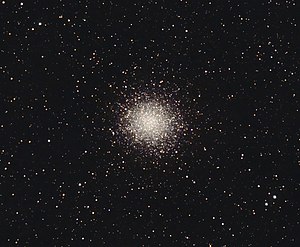Messier 14
|
Globular cluster Messier 14 |
|
|---|---|

|
|
| Messier 14 photographed with an amateur telescope | |
| AladinLite | |
| Constellation | Snake bearer |
|
Position equinox : J2000.0 , epoch : J2000.0 |
|
| Right ascension | 17 h 37 m 36.15 s |
| declination | −3 ° 14 ′ 45.3 ″ |
| Appearance | |
| Concentration class | VIII |
| Brightness (visual) | 8.32 likes |
| Brightness (B-band) | 9.55 mag |
| Angular expansion | 11.0 ' |
|
Color excess E (BV) (redness) |
0.60 |
| Physical data | |
| Affiliation | Milky Way |
| Integrated spectral type | F4 |
| Redshift | −0.000371 ± 0.000017 |
| Radial velocity | (−111 ± 5) km / s |
| distance | 30.3 kLj (9.3 kpc ) |
| Absolute brightness | −8.89 mag |
| Concentration lg (r t / r c ) | 1.6 |
| Metallicity [Fe / H] | −1.39 |
| history | |
| discovery | Charles Messier |
| Discovery date | June 1, 1764 |
| Catalog names | |
| M 14 • NGC 6402 • C 1735-032 • GCl 72 • | |
Messier 14 or M14 (also known as NGC 6402 ) is a 7.9 mag bright globular cluster with an area of 11.0 'in the constellation of the Serpent Bearer (Ophiuchus). The brightness information from various sources is 7.6 to 8.3 mag.
With over 1 million solar masses, it is the heaviest, but due to extinction it is the faintest of the 5 globular clusters of the constellation (M9, 10, 12, 14 and 107). Therefore it can hardly be seen in 10 × 50 binoculars . Telescopes with an aperture of 15–20 cm only show a spotty disc, while the first single stars only appear at a 30 cm aperture and at least 150x magnification.
M14 was discovered by the French astronomer Charles Messier on June 1, 1764 , 2 days after M10 and M12. But it was not until 1783 that Wilhelm Herschel was able to break it down into single stars, the brightest of which is only 14th magnitude. The distance is between 28,000 and 56,000 light years, depending on the measurement method. One difficulty is that the galactic dust attenuates its brightness by about 2 magnitudes.
The center of the cluster looks speckled, has a dark cloud in the southeast and cannot be completely resolved even in large telescopes; some star chains cross it diagonally. A total of 68 variables were found, including 55 of the typical, old RR Lyrae stars. In 1938 a nova of 16 mag appeared, but it was not discovered in photos until 1964 - the first time in a globular cluster.
literature
- Ronald Stoyan : Atlas of the Messier Objects. The highlights of the deep sky . Oculum-Verlag, Erlangen 2006, pp. 102-103, ISBN 3-938469-07-2 .
- Bernd Koch, Stefan Korth: The Messier Objects. The 110 classic destinations for sky watchers . Kosmos-Verlag, Stuttgart 2010, pp. 32–33, ISBN 978-3-440-11743-9 .

